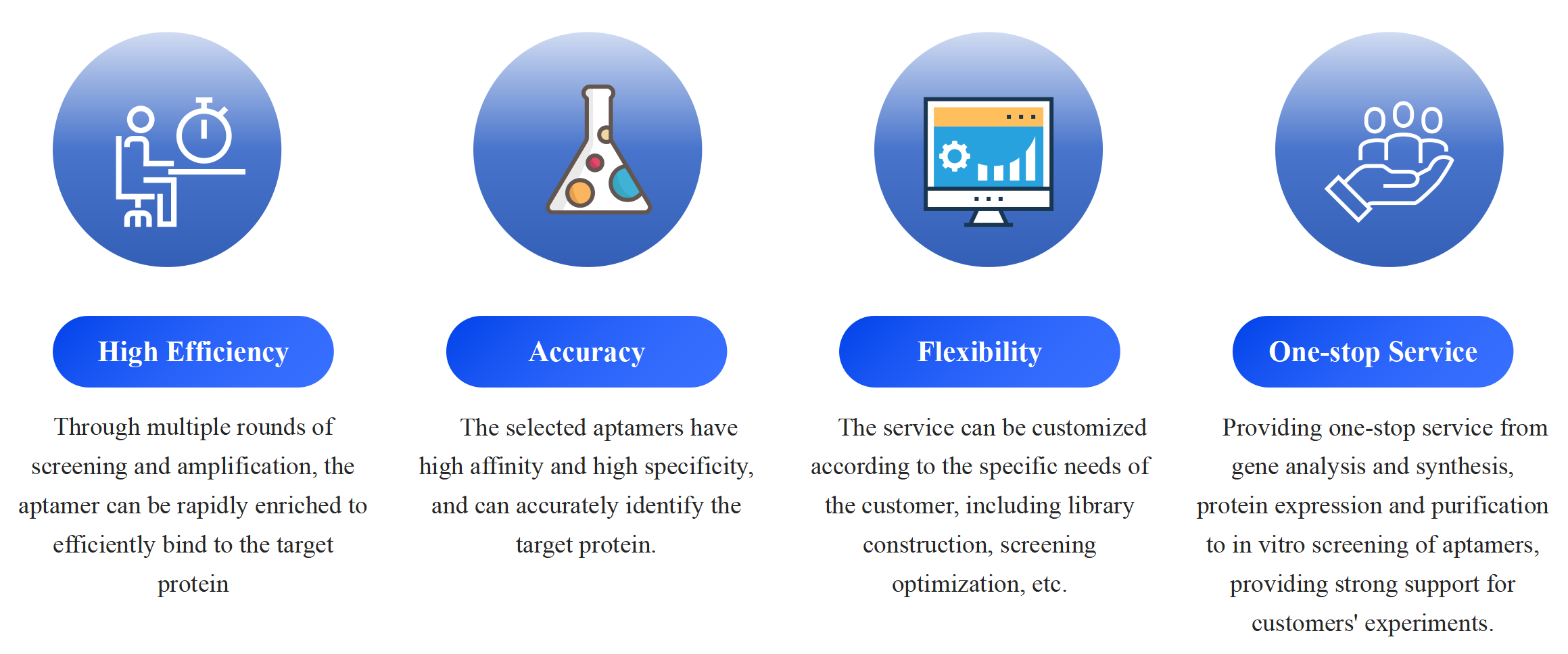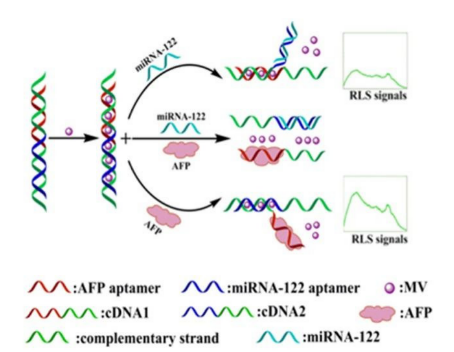Service Line:+86-022-82164980
Address:FL-4, Building A5, International Enterprise Community, Tianjin, China
Email:[email protected]
Protein aptamers are a class of artificially screened or naturally occurring nucleic acid molecules that can specifically recognize and bind proteins, including DNA and RNA aptamers. Target protein aptamer screening refers to screening out aptamers that can bind to specific proteins efficiently from a large number of randomly generated nucleic acid libraries. The main process includes incubating the random oligonucleotide library with the target protein, separating the bound and unbound oligonucleotides, amplicating the bound oligonucleotides, and repeating these steps for many rounds to enrich the aptamers with high affinity and specificity.
The target protein aptamer screening service is designed to provide researchers with efficient and precise tools to discover aptamers that bind to specific proteins through aptamer screening technology. These aptamers have broad application prospects in medicine development, disease identification, biosensing and other fields.
SELEX Method for Aptamer Screening
.png)
Fig.1 SELEX Screening
|
Service item |
Description |
|
Preparation of aptamer library |
Chemical synthesis of ssDNA/RNA libraries with capacities of 1×10^13 to 1×10^15. |
|
SELEX screening |
Target incubation, binding sequence elution, amplification; Repeat the above steps 3~4 times to screen out the target binding sequence; |
|
NGS sequencing |
Using NGS sequencing, bioinformatics, and biophysical methods to obtain basic information about candidate aptamers. |
|
Aptamer synthesis |
High quality aptamer synthesis and HPLC purification with MS report. |
|
Optimization
|
Different modification methods have been selected for different needs and applications, such as biotin, fluorescent dyes, etc. |
|
Affinity test |
Flow cytometry, ITC, SPR, QCM and other techniques were used to determine KD. |
Aptamer vs Antibody
Antibodies are large proteins that are widely used in diagnostic tests and treatments. The two have many similarities, as follows:
Specific recognition: Both antibodies and aptamers have the ability to recognize and bind to target substances with high specificity and affinity. This specific recognition is the basis for their role in biomedical applications.
Biomolecules: Both are biomolecules that are bioactive and biocompatible and can function in an organism's internal or external environment.
Advantage of Aptamer vs Antibody
Aptamers have a number of significant advantages over antibodies:
Ease of synthesis: Aptamers can be synthesized using solid-phase oligonucleotides, whereas antibodies must be obtained using less efficient biochemical or biological methods. This is particularly important if synthesis is to be scaled up.
Easy modification: Since the aptamers are synthesized chemically, it is easy to extend the synthesis to include modifications.
Library synthesis: Because of the way solid-phase oligonucleotide synthesis works, it is easy to generate large libraries similar to DNA and RNA aptamers, which is necessary for selection experiments.
Low immunogenicity: Antibodies usually cause an immune response when used as a therapeutic agent in the body (they are immunogenic), while DNA and RNA aptamers can be designed to be non-immunogenic.
Thermal stability: single-chain oligonucleotides are stable at high temperatures, while antibodies are irreversibly denatured at high temperatures.
Uptake: DNA and RNA aptamers are usually smaller (lower molecular weight) than antibodies, which means they enter the tissue faster; However, the small size of aptamers makes them susceptible to renal filtration (which can be overcome by binding to peptides or polymers). But this increases the molecular weight).
Shelf life, storage, and distribution: Oligonucleotides can be freeze-dried and stored for long periods of time, making them easy to transport, whereas many antibodies have a limited shelf life.
Advantages of Aptamer Screening

FAQ-Protein Aptamer Screening
1. What is a protein-nucleic aptamer?
A: Because of the special properties of proteins and small molecules, only a few atoms interact when the two combine, and with the combination of the two, nucleic acid aptamer technology rises. The interaction between genetic acid and proteins plays an important role in cell activation, reproduction, aging, and apoptosis. Because the nucleotides of RNA and DNA can bind to specific proteins and a wide range, proteins that are not involved in disease states can also bind to them. In recent years, protein aptamer technology has become a new technology for understanding the principle of aptamer and protein interactions and an important molecular biological means in modern medicine. The ability of aptamer to target protein degradation is of great significance in some chronic diseases, rare diseases, cancer, and other human research fields, so the aptamer technology has been widely used in protein degradation technology. The protein aptamer selects the sequence from the synthetic oligonucleotide library by SELEX technology. This sequence can be a DNA or RNA sequence. Generally, the sequence length is less than 100 nt, and there is a random sequence of 20-60 nt in the middle. At both ends of the sequence researchers are designed to have invariant primer binding sites, which can fold themselves into unique secondary or tertiary structures in the absence of complementary strands and then bind to target proteins through hydrogen bonds, van der Waals forces.

Fig 2: A Schematic representation of the aptamer biosensor. (Reference source: Liu L, Wang H, Xie B, Zhang B, Lin Y, Gao L. Detection of Alpha-Fetoprotein Using Aptamer-Based Sensors. Biosensors (Basel). 2022 Sep 21;12(10):780.)
2. In the protein-nucleic aptamer screening service, if we encounter the problem of low screening efficiency, how do we solve it, and how to improve the screening efficiency?
A: In the protein-nucleic acid aptamer screening service, the efficiency of nucleic acid screening is very important. The screening efficiency determines whether we can get high-affinity aptamers. However, in some screening experiments, due to the unreasonable design of aptamer libraries, low PCR amplification efficiency, or poor single-chain separation effect of oligo-aptamers, resulting in the whole screening service process, our screening cycle is too long, the screening cost is increased, and the aptamer we obtained may not have high affinity. To improve the screening efficiency of aptamer services, KMD Bioscience first builds oligonucleotide libraries with more sequences by increasing the library diversity, which can increase the efficiency of screening in the experiment and is more likely to obtain high-affinity aptamers. Then KMD Bioscience Biological improved the aptamer screening method, technicians with high-efficiency capillary electrophoresis (HPCE), and microfluidic chip technology, helped to complete the aptamer efficient separation and screening services, this new technology compared with the previous technology, aptamer separation speed faster, and need to reduce manpower. At the same time, the technicians of KMD Bioscience also optimize the screening conditions, such as target concentration, incubation time, washing times, etc., to reduce the number of rounds in the screening process, and shorten the screening cycle time. We have also introduced new screening strategies, such as dual-target screening and competitive screening, to help improve screening efficiency.
3. In the protein-nucleic aptamer screening service, if we encounter the problem of low screening specificity, how can we solve it, and how can we improve the specificity?
A: in protein-nucleic acid aptamer screening services, the specificity of the aptamer determines the product can normal delivery, due to the screening process of unspecific binding, or target pollution, problems such as not strict screening conditions, can lead to the aptamer not being able to accurately identify the target, and to affect the subsequent application of our products.KMD Bioscience can use the systematic evolution technology of exponentially enriched ligands (SELEX) to conduct in vitro nucleic acid aptamer screening. Through repeated screening and PCR amplification, the aptamer sequence that can bind to the target protein is enriched. In this process, the researchers increased the stringency of the screening step by step by increasing the specificity of the aptamer by reducing the target concentration and increasing the elution intensity. Meanwhile, the introduction of chemically modified nucleotides in the screening process can change the physical properties of the aptamers, thus causing the enhanced binding capacity of the nucleic acid aptamers. In addition to the above method, we can also use the negative screen to improve the specificity of nucleic acid aptamer, through the screening process by adding the protein structure similar to the target but not specific binding molecules as a negative screen target, so negative screen is helpful to remove those prone to non-specific binding sequence, and improve the specificity of our target sequence.
4. In the protein-nucleic aptamer screening service, if we encounter the problem of poor stability of the screened aptamer, how do we solve it, and how do we improve the stability?
A: In the process of protein-nucleic aptamer screening services, we may encounter the selection of nucleic acid aptamer instability, the structure of the aptamer is easy to be affected by the surrounding environmental factors, such as temperature, pH, salt ion strength, etc., the above factors can lead to the aptamer effect in practical application, and even have no effect. In response to this, KMD Bioscience helps improve the stability of the aptamer by making chemical modifications to the aptamers, such as introducing the chemical group that can resist the degradation of nucleases. At the same time, KMD Bioscience also modified the secondary or tertiary structure of the nucleic acid aptamer to make the structure of the aptamer more stable and help us reduce the inactivation of the aptamer due to structural changes. At the same time, KMD Bioscience also conducted a buffer optimization, selecting the buffer system suitable for the aptamer structure to help the aptamer maintain structural stability. At the same time, in the storage process of the aptamer, we should also pay attention to the control of temperature and humidity to avoid the degeneration of the aptamer and affecting its function. Finally, we can adopt the method of adding appropriate additives to prevent the degradation and oxidation of the aptamer.
5. What are the advantages and disadvantages of protein-nucleic aptamers? What is the application scope of this technology?
A: Protein nucleic aptamer technology can recognize and bind target proteins with high specificity and high affinity, and the degree of protein-aptamer binding is even about the degree of antibody binding to antigen. Nucleic acid aptamers can be quickly and easily synthesized in vitro through the existing mature DNA synthesis technology, PCR amplification technology, or RNA in vitro transcription technology, and the cost of synthesis is relatively low, this synthesis is convenient to undergo chemical modification, to meet the different applications of researchers in various aspects. The molecular weight of nucleic acid aptamer is small, with good stability, and can maintain the original structure under various chemical solvents and high temperatures. At the same time, because of its small molecular weight, its aptamer has low immunogenicity, which can reduce the side effects in clinical applications. In addition, nucleic acid aptamers have a wide range of target molecules, a variety of biological macromolecules, and carbohydrates can be target molecules. However, aptamers also have disadvantages. In the internal environment, aptamers may be degraded by enzymes in the body, or they may be cleared when passing through the kidney, and aptamer screening is difficult and for a long time. Protein nucleic aptamers are mainly used in drug screening, gene therapy at targeted sites, and genetic diagnosis of some diseases.
How to Order?

If you have any questions regarding our services or products, please feel free to contact us by E-mail: [email protected] or Tel: +86-400-621-6806